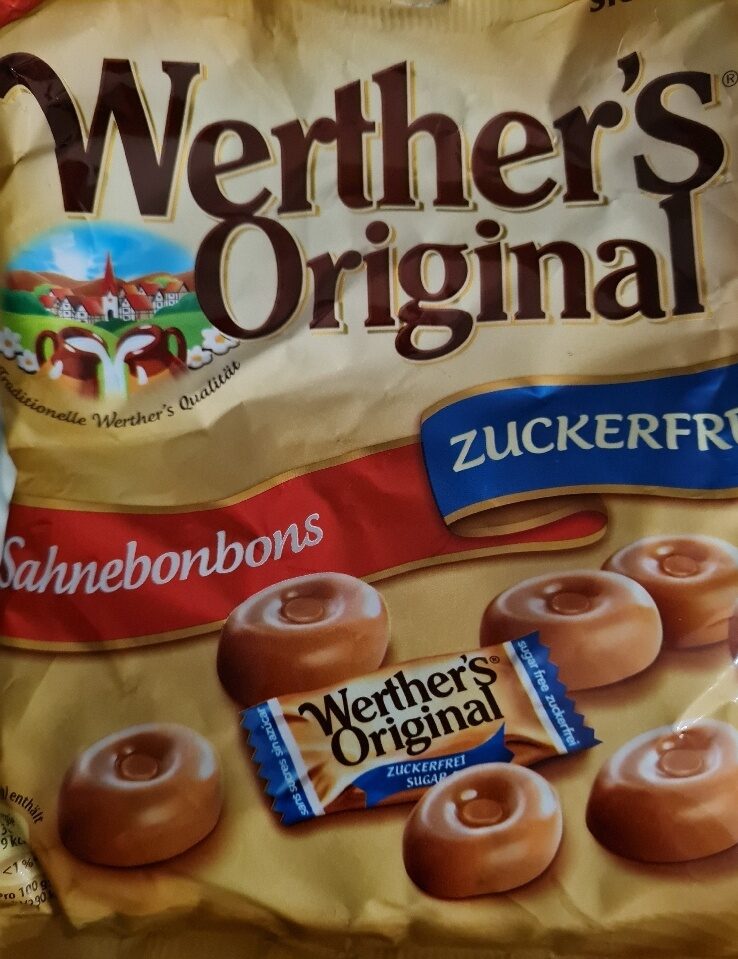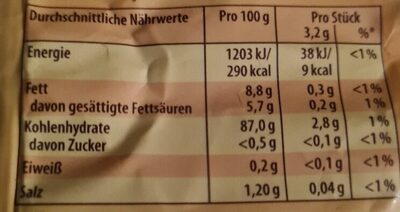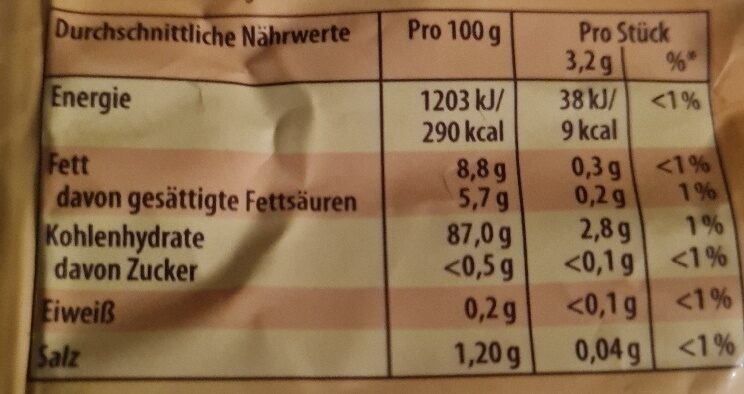உணவு வெளிப்படைத்தன்மையை வழக்கமாக்க உதவுங்கள்!
ஒரு இலாப நோக்கற்ற அமைப்பாக, உலகெங்கிலும் உள்ள நுகர்வோருக்கு அவர்கள் என்ன சாப்பிடுகிறார்கள் என்பதைத் தொடர்ந்து தெரிவிக்க உங்கள் நன்கொடைகளை நாங்கள் சார்ந்துள்ளோம்.
உணவுப் புரட்சி உங்களிடமிருந்து தொடங்குகிறது!
Sahnebonbons Zuckerfreie - Werther's Original - 70 g
Sahnebonbons Zuckerfreie - Werther's Original - 70 g
This product page is not complete. You can help to complete it by editing it and adding more data from the photos we have, or by taking more photos using the app for Android or iPhone/iPad. Thank you!
×
பார்கோடு: 4014400907636 (EAN / EAN-13)
Common name: zuckerfreie sahnebonbons mit süßungsmitteln.
Quantity: 70 g
Packaging: en:Plastic, en:Bag
Brands: Werther's Original, Storck
Categories: en:Snacks, en:Sweet snacks, en:Confectioneries, en:Candies, en:Hard candies
Labels, certifications, awards:
en:Low or no sugar, en:Green Dot, en:Made in Germany, No sugar
Origin of ingredients: செருமனி
Manufacturing or processing places: Berlin, Alemania
Traceability code: 020503140020
Link to the product page on the official site of the producer: https://www.werthers-original.de/de/prod...
Stores: Carrefour, Coop, Elite Brands
Countries where sold: பொலிவியா, டென்மார்க், செருமனி, சிங்கப்பூர்
Matching with your preferences
Health
Ingredients
-
10 ingredients
இடாய்ச்சு மொழி: Süßungsmittel Isomalt, Butter (7,9 %), Sahne (7 %), Salz, Aromen, Emulgator Lecithine (Soja), Süßungsmittel Acesulfam K.ஒவ்வாமை ஊக்கிகள்: en:Milk, en:Soybeans
Food processing
-
Ultra processed foods
Elements that indicate the product is in the en:4 - Ultra processed food and drink products group:
- தீவனச் சேர்க்கைப் பொருள்: E322
- தீவனச் சேர்க்கைப் பொருள்: E950
- தீவனச் சேர்க்கைப் பொருள்: E953
- Ingredient: Emulsifier
- Ingredient: Flavouring
- Ingredient: Sweetener
Food products are classified into 4 groups according to their degree of processing:
- Unprocessed or minimally processed foods
- Processed culinary ingredients
- Processed foods
- Ultra processed foods
The determination of the group is based on the category of the product and on the ingredients it contains.
தீவனச் சேர்க்கைப் பொருட்கள்
-
E322
Lecithin: Lecithin -UK: , US: , from the Greek lekithos, "egg yolk"- is a generic term to designate any group of yellow-brownish fatty substances occurring in animal and plant tissues, which are amphiphilic – they attract both water and fatty substances -and so are both hydrophilic and lipophilic-, and are used for smoothing food textures, dissolving powders -emulsifying-, homogenizing liquid mixtures, and repelling sticking materials.Lecithins are mixtures of glycerophospholipids including phosphatidylcholine, phosphatidylethanolamine, phosphatidylinositol, phosphatidylserine, and phosphatidic acid.Lecithin was first isolated in 1845 by the French chemist and pharmacist Theodore Gobley. In 1850, he named the phosphatidylcholine lécithine. Gobley originally isolated lecithin from egg yolk—λέκιθος lekithos is "egg yolk" in Ancient Greek—and established the complete chemical formula of phosphatidylcholine in 1874; in between, he had demonstrated the presence of lecithin in a variety of biological matters, including venous blood, in human lungs, bile, human brain tissue, fish eggs, fish roe, and chicken and sheep brain. Lecithin can easily be extracted chemically using solvents such as hexane, ethanol, acetone, petroleum ether, benzene, etc., or extraction can be done mechanically. It is usually available from sources such as soybeans, eggs, milk, marine sources, rapeseed, cottonseed, and sunflower. It has low solubility in water, but is an excellent emulsifier. In aqueous solution, its phospholipids can form either liposomes, bilayer sheets, micelles, or lamellar structures, depending on hydration and temperature. This results in a type of surfactant that usually is classified as amphipathic. Lecithin is sold as a food additive and dietary supplement. In cooking, it is sometimes used as an emulsifier and to prevent sticking, for example in nonstick cooking spray.Source: Wikipedia (ஆங்கிலம்)
-
E950
Acesulfame potassium: Acesulfame potassium - AY-see-SUL-faym-, also known as acesulfame K -K is the symbol for potassium- or Ace K, is a calorie-free sugar substitute -artificial sweetener- often marketed under the trade names Sunett and Sweet One. In the European Union, it is known under the E number -additive code- E950. It was discovered accidentally in 1967 by German chemist Karl Clauss at Hoechst AG -now Nutrinova-. In chemical structure, acesulfame potassium is the potassium salt of 6-methyl-1‚2,3-oxathiazine-4-3H--one 2‚2-dioxide. It is a white crystalline powder with molecular formula C4H4KNO4S and a molecular weight of 201.24 g/mol.Source: Wikipedia (ஆங்கிலம்)
-
E953
Isomalt: Isomalt is a sugar substitute, a type of sugar alcohol used primarily for its sugar-like physical properties. It has little to no impact on blood sugar levels, and does not stimulate the release of insulin. It also does not promote tooth decay, i.e. is tooth-friendly. Its energy value is 2 kcal/g, half that of sugars. However, like most sugar alcohols, it carries a risk of gastric distress, including flatulence and diarrhea, when consumed in large quantities -above about 20-30 g per day-. Isomalt may prove upsetting to the intestinal tract because it is incompletely absorbed in the small intestine, and when polyols pass into the large intestine, they can cause osmotically induced diarrhea and stimulate the gut flora, causing flatulence. As with other dietary fibers, regular consumption of isomalt can lead to desensitisation, decreasing the risk of intestinal upset. Isomalt can be blended with high-intensity sweeteners such as sucralose, giving a mixture that has the same sweetness as sugar. Isomalt is an equimolar mixture of two mutually diastereomeric disaccharides, each composed of two sugars: glucose and mannitol -α-D-glucopyranosido-1‚6-mannitol- and also glucose and sorbitol -α-D-glucopyranosido-1‚6-sorbitol-. Complete hydrolysis of isomalt yields glucose -50%-, sorbitol -25%-, and mannitol -25%-. It is an odorless, white, crystalline substance containing about 5% water of crystallisation. Isomalt has a minimal cooling effect -positive heat of solution-, lower than many other sugar alcohols, in particular, xylitol and erythritol. Isomalt is manufactured in a two-stage process in which sucrose is first transformed into isomaltulose, a reducing disaccharide -6-O-α-D-glucopyranosido-D-fructose-. The isomaltulose is then hydrogenated, using a Raney nickel catalyst. The final product — isomalt — is an equimolar composition of 6-O-α-D-glucopyranosido-D-sorbitol -1‚6-GPS- and 1-O-α-D-glucopyranosido-D-mannitol-dihydrate -1‚1-GPM-dihydrate-. Isomalt has been approved for use in the United States since 1990. It is also permitted for use in Australia, New Zealand, Canada, Mexico, Iran, the European Union, and other countries. Isomalt is widely used for the production of sugar-free candy, especially hard-boiled candy, because it resists crystallisation much better than the standard combinations of sucrose and corn syrup. It is used in sugar sculpture for the same reason.Source: Wikipedia (ஆங்கிலம்)
Ingredients analysis
-
en:Palm oil free
No ingredients containing palm oil detected
-
en:Non-vegan
Non-vegan ingredients: வெண்ணெய், பாலாடை
-
en:Maybe vegetarian
Ingredients that may not be vegetarian: en:Flavouring, E322
-
Details of the analysis of the ingredients
de: Süßungsmittel (Isomalt), Butter 7.9%, Sahne 7%, Salz, Aromen, Emulgator (Lecithine), Süßungsmittel (Acesulfam K)- Süßungsmittel -> en:sweetener - percent_min: 80.3 - percent_max: 85.1
- Isomalt -> en:e953 - vegan: yes - vegetarian: yes - percent_min: 80.3 - percent_max: 85.1
- Butter -> en:butter - vegan: no - vegetarian: yes - ciqual_proxy_food_code: 16400 - percent_min: 7.9 - percent: 7.9 - percent_max: 7.9
- Sahne -> en:cream - vegan: no - vegetarian: yes - ciqual_food_code: 19402 - percent_min: 7 - percent: 7 - percent_max: 7
- Salz -> en:salt - vegan: yes - vegetarian: yes - ciqual_food_code: 11058 - percent_min: 0 - percent_max: 1.2
- Aromen -> en:flavouring - vegan: maybe - vegetarian: maybe - percent_min: 0 - percent_max: 1.2
- Emulgator -> en:emulsifier - percent_min: 0 - percent_max: 1.2
- Lecithine -> en:e322 - vegan: maybe - vegetarian: maybe - percent_min: 0 - percent_max: 1.2
- Süßungsmittel -> en:sweetener - percent_min: 0 - percent_max: 1.2
- Acesulfam K -> en:e950 - vegan: yes - vegetarian: yes - percent_min: 0 - percent_max: 1.2
- Süßungsmittel -> en:sweetener - percent_min: 80.3 - percent_max: 85.1
ஊட்டச்சத்து
-
Poor nutritional quality
⚠ ️Warning: the amount of fruits, vegetables and nuts is not specified on the label, it was estimated from the list of ingredients: 0This product is not considered a beverage for the calculation of the Nutri-Score.
Positive points: 0
- Proteins: 0 / 5 (value: 0.2, rounded value: 0.2)
- Fiber: 0 / 5 (value: 0.1, rounded value: 0.1)
- Fruits, vegetables, nuts, and colza/walnut/olive oils: 0 / 5 (value: 0, rounded value: 0)
Negative points: 13
- Energy: 3 / 10 (value: 1203, rounded value: 1203)
- Sugars: 0 / 10 (value: 0.5, rounded value: 0.5)
- Saturated fat: 5 / 10 (value: 5.7, rounded value: 5.7)
- Sodium: 5 / 10 (value: 480, rounded value: 480)
The points for proteins are not counted because the negative points are greater or equal to 11.
Nutritional score: (13 - 0)
Nutri-Score:
-
Nutrient levels
-
கொழுப்பு in moderate quantity (8.8%)
What you need to know- A high consumption of fat, especially saturated fats, can raise cholesterol, which increases the risk of heart diseases.
Recommendation: Limit the consumption of fat and saturated fat- Choose products with lower fat and saturated fat content.
-
நிறைவுற்ற கொழுப்பு in high quantity (5.7%)
What you need to know- A high consumption of fat, especially saturated fats, can raise cholesterol, which increases the risk of heart diseases.
Recommendation: Limit the consumption of fat and saturated fat- Choose products with lower fat and saturated fat content.
-
சீனி in low quantity (0.5%)
What you need to know- A high consumption of sugar can cause weight gain and tooth decay. It also augments the risk of type 2 diabetes and cardio-vascular diseases.
Recommendation: Limit the consumption of sugar and sugary drinks- Sugary drinks (such as sodas, fruit beverages, and fruit juices and nectars) should be limited as much as possible (no more than 1 glass a day).
- Choose products with lower sugar content and reduce the consumption of products with added sugars.
-
உப்பு in moderate quantity (1.2%)
What you need to know- A high consumption of salt (or sodium) can cause raised blood pressure, which can increase the risk of heart disease and stroke.
- Many people who have high blood pressure do not know it, as there are often no symptoms.
- Most people consume too much salt (on average 9 to 12 grams per day), around twice the recommended maximum level of intake.
Recommendation: Limit the consumption of salt and salted food- Reduce the quantity of salt used when cooking, and don't salt again at the table.
- Limit the consumption of salty snacks and choose products with lower salt content.
-
-
Nutrition facts
Nutrition facts As sold
for 100 g / 100 mlAs sold
per serving (3.2 g)Compared to: en:Candies ஆற்றல் 1,203 kj
(290 kcal)38.5 kj
(9 kcal)+22% கொழுப்பு 8.8 g 0.282 g +1,834% நிறைவுற்ற கொழுப்பு 5.7 g 0.182 g +2,171% Carbohydrates 87 g 2.78 g +31% சீனி < 0.5 g < 0.016 g -98% Polyols 86 g 2.75 g Fiber 0.1 g 0.003 g புரதம் 0.2 g 0.006 g -59% உப்பு 1.2 g 0.038 g +845% Fruits‚ vegetables‚ nuts and rapeseed‚ walnut and olive oils (estimate from ingredients list analysis) 0 % 0 %
சுற்றுச்சூழல்
-
Eco-Score B - Low environmental impact
⚠ ️The full impact of transportation to your country is currently unknown.The Eco-Score is an experimental score that summarizes the environmental impacts of food products.→ The Eco-Score was initially developped for France and it is being extended to other European countries. The Eco-Score formula is subject to change as it is regularly improved to make it more precise and better suited to each country.Life cycle analysis
-
Average impact of products of the same category: A (Score: 86/100)
Category: Hard candy and lollipop
Category: Hard candy and lollipop
- PEF environmental score: 0.23 (the lower the score, the lower the impact)
- including impact on climate change: 1.73 kg CO2 eq/kg of product
Stage Impact Agriculture
52.2 %Processing
28.9 %Packaging
6.9 %Transportation
9.9 %Distribution
2.0 %Consumption
0.0 %
Bonuses and maluses
-
Origins of ingredients with a high impact
Malus:
Environmental policy: +4
Transportation: 0
Origin of the product and/or its ingredients % of ingredients Impact செருமனி 100 %Medium
-
Packaging with a medium impact
Malus: -10
Shape Material Recycling Impact 1 Bag Plastic Recycle High
Eco-Score for this product
-
Impact for this product: B (Score: 79/100)
Product: Sahnebonbons Zuckerfreie - Werther's Original - 70 g
Life cycle analysis score: 86
Sum of bonuses and maluses: -10
Final score: 79/100 (The score of products with non-recyclable and non-biodegradable packaging materials is capped at 79 (grade B).)
-
Carbon footprint
-
Equal to driving 0.9 km in a petrol car
173 g CO² per 100g of product
The carbon emission figure comes from ADEME's Agribalyse database, for the category: Hard candy and lollipop (Source: ADEME Agribalyse Database)
Stage Impact Agriculture
33.5 %Processing
38.9 %Packaging
10.8 %Transportation
15.8 %Distribution
1.0 %Consumption
0.0 %
Packaging
-
Packaging with a medium impact
-
Packaging parts
1 x Bag (Plastic)
-
பேக்கேஜிங் பொருட்கள்
Material % பேக்கேஜிங் எடை 100 கிராம் தயாரிப்புக்குப் பேக்கேஜிங் எடை Plastic
-
Transportation
-
Origins of ingredients
Origins of ingredients with a high impact
Origin of the product and/or its ingredients % of ingredients Impact செருமனி 100 %Medium
Report a problem
-
Incomplete or incorrect information?
Category, labels, ingredients, allergens, nutritional information, photos etc.
If the information does not match the information on the packaging, please complete or correct it. Open Food Facts is a collaborative database, and every contribution is useful for all.
Data sources
Product added on by openfoodfacts-contributors
Last edit of product page on by 5m4u9.
தயாரிப்பு பக்கத்தையும் திருத்தியது annelotte, beniben, celine2018, chevalstar, foodvisor, grumpf, inf, itsjustruby, jeanbono, manu1400, markuso, packbot, quechoisir, yuka.Va9LPezaAsIiJMP8_9pp-BmrLuTpUtp-I04WoQ.











